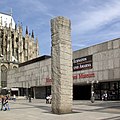Biography
Heinz Mack was born in 1931 in the small town of Lollar in Germany. Between 1950 and 1956 he studied at the Kunstakademie Düsseldorf. In 1957 together with Otto Piene he started a series of what were called Abendausstellungen (evening exhibitions) at their studio in Düsseldorf. This series was the initial event for the formation of the group ZERO (with Mack, Piene and Günther Uecker as its nucleus) and the international ZERO movement. Among the participants of the ZERO movement were Yves Klein, Lucio Fontana, Piero Manzoni and Jean Tinguely. [1]
In the early 1960s, Mack worked, with Gotthard Graubner, as an art teacher at the Lessing Gymnasium, Düsseldorf. [2] [3] In 1964 Mack, Piene and Uecker arranged the "ZERO Lichtraum (Hommage á Lucio Fontana)" at the 1964 documenta in Kassel. From 1964 to 1966 Mack lived and worked in New York where the Howard Wise Gallery presented a solo exhibition in 1966.
Although known for his minimalist outdoor sculptures, Mack also produced smaller works, both static and kinetic. Light Dynamo #2' from 1966, in the collection of the Honolulu Museum of Art, is an example of his rotating disc kinetic sculptures. Since 1991, he has been producing brightly colored, abstract, paintings in acrylic. [4]
1970 Mack was invited as visiting professor to Osaka, Japan. In the same year he represented Germany at the 1970 Venice Biennale (together with Günther Uecker, Georg Karl Pfahler and Thomas Lenk). For the 1972 Summer Olympics in Munich he created an illuminated "Wasserwolke" (Water cloud). In 1972 he was asked to create a 230 ft tall sculpture for the United Nations headquarters in New York (not realized).

The Kunstpalast, formerly Kunstmuseum Düsseldorf is an art museum in Düsseldorf.

Otto Piene was a German-American artist specializing in kinetic and technology-based art, often working collaboratively. He lived and worked in Düsseldorf, Germany; Cambridge, Massachusetts; and Groton, Massachusetts.
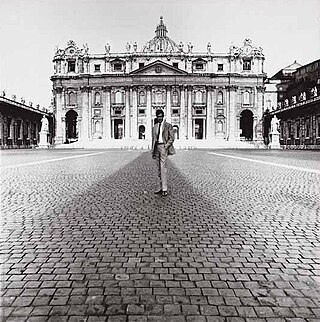
Lothar Wolleh was a well-known German photographer.
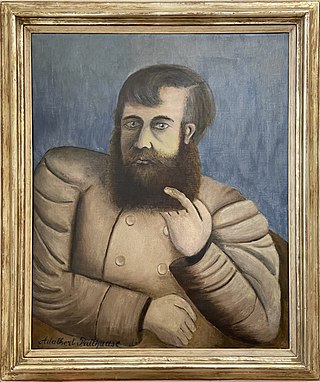
Otto Pankok was a German painter, printmaker, and sculptor.

Günther Uecker is a German sculptor, op artist and installation artist.
Charles Paul Wilp was a German advertising-designer, artist, photographer and short-movie-editor.
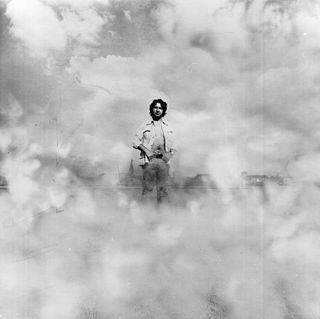
Gotthard Graubner was a German painter, born in Erlbach, in Saxony, Germany.
Horst Gläsker is a German artist. His work is a symbiosis of music, dance, theatre, drawing, painting, sculpture, installation and architecture.
Karl Otto Götz often simply called K.O. Götz, was a German artist, filmmaker, draughtsman, printmaker, writer and professor of art at the Kunstakademie Düsseldorf. He was one of the oldest living and active artists older than 100 years of age and is best remembered for his explosive and complex abstract forms. His powerful, surrealist-inspired works earned him international recognition in exhibitions like documenta II in 1959. Götz never confined himself to one specific style or artistic field. He also explored generated abstract forms through television art. Götz is one of the most important members of the German Art Informel movement. His works and teachings influenced future artists such as Sigmar Polke, Nam June Paik and Gerhard Richter. He lived in Wolfenacker from 1975 until his death.
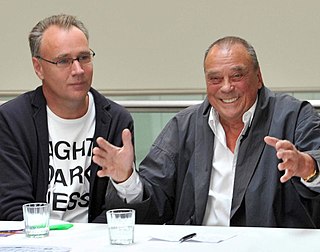
Mat(tijs) Visser studied architecture in Delft, the Netherlands and is since then an organiser of performances and art exhibitions. He was head of exhibitions at Museum Kunst Palast in Düsseldorf for eight years (2001–08), curated historical exhibitions and is best known for his Artempo exhibition at Palazzo Fortuny in Venice. He was the founding director of the international ZERO foundation in Düsseldorf from 2008 to 2017 and is a researcher at the Institute for Contemporary Archeology in Antwerp. As director from 0-projects he advises museums around the world on collection presentations.

Hans-Jürgen Schult, known professionally as HA Schult, is a German installation, happening and conceptual artist known primarily for his object and performance art and more specifically his work with garbage. He is one of the first artists to deal with the world's ecological imbalance in his work and has therefore been called an "eco-art pioneer". His best known works include the touring work, Trash People, which exhibited on all continents, and the Save The Beach hotel, a building made of garbage.

Dieter Jung is a German artist working in the field of holography, painting and installation art. He lives and works in Berlin.

Zero was an artist group founded in the late 1950s in Düsseldorf by Heinz Mack and Otto Piene. Piene described it as "a zone of silence and of pure possibilities for a new beginning". In 1961 Günther Uecker joined the initial founders. ZERO became an international movement, with artists from Germany, the Netherlands, Belgium, France, Switzerland, and Italy.
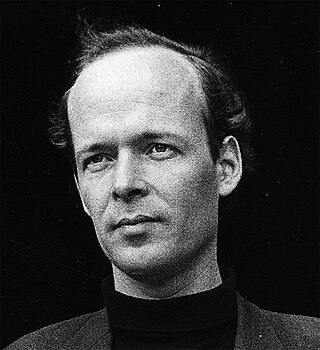
Gerhard von Graevenitz was a German kinetic artist, co-founding member of the Nouvelle Tendance and member of the op-art movement. He also belonged to the international circle of the Zero-Group. He is seen as one of the uncompromising representatives of the constructive-concrete art of the younger generation.
Kuno Gonschior was a German painter.

Anatol Herzfeld was a German sculptor and mixed-media artist, and also a policeman. A student of Joseph Beuys, he primarily used wood, iron and stone as materials. As an artist, he simply signed Anatol. He received attention for a happening, crossing the Rhine in a boat he created with Beuys, after Beuys had been expelled from the Kunstakademie Düsseldorf.

The Mayor Gallery is an art gallery located in Cork Street, London, England. Since its foundation by Fred Mayor in partnership with Douglas Cooper in 1925, it has promoted modern and contemporary art. Since the early 1970s, under the new impulse given by James Mayor, Fred Mayor's son, the Gallery started to focus actively on the work of contemporary American artists from the Pop art movement but also Conceptual art and Abstract expressionism such as Eva Hesse, Roy Lichtenstein, Agnes Martin, Claes Oldenburg, Robert Rauschenberg, Robert Ryman, Cy Twombly and Andy Warhol. More recently, taking further its interest for Minimal art and Dada, the Gallery has been promoting artists of the international Zero (art) movement, including Heinz Mack, Otto Piene amongst others.

The Dutch Nul Group, which consisted of Armando, Jan Henderikse, Henk Peeters and Jan Schoonhoven (1914-1994), manifested itself in form and name in 1961. On 1 April 1961, a stone's throw from the Amsterdam Stedelijk Museum, Galerie 201 organized the ‘Internationale tentoonstelling van NIETS’. The 'Manifest tegen niets' and 'Einde' ('Ending'), a pamphlet published at the same time, were among the first activities of the Nul group. ‘We need art like we need a hole in the head,’ the pamphlet 'Einde' states; ‘From now on the undersigned pledge to work to disband art circles and close down exhibition facilities, which can then finally be put to worthier use.’ The 'Einde' pamphlet imagines a new beginning, as Armando and Henk Peeters had already proclaimed in texts written several years earlier for the Dutch Informals.
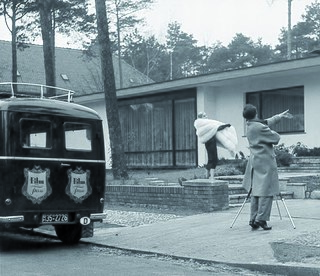
Franz Christian Gundlach was a German photographer, gallery owner, collector, curator and founder.

Margarete Lauter was a German art dealer with the first Art Gallery for international contemporary art established in 1963 in Mannheim (Germany) after the Second World War 1945 mainly presenting works by German, French, Spanish, Italian, Japanese, Korean, Romanian, Belgian, Hungarian, Israeli, Slovenian, Austrian and US artists.




